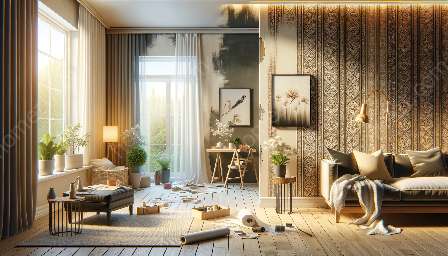When it comes to homemaking and interior decor, painting techniques play a significant role in transforming the look and feel of a space. Whether you're trying to achieve a specific aesthetic or breathe new life into a room, understanding various painting techniques can be immensely beneficial. In this comprehensive guide, we'll explore different painting methods that can be used for wall painting and wallpapering, and how these techniques can be integrated into your home decor.
Faux Painting Techniques
Faux painting, also known as faux finishing, involves replicating the appearance of materials such as wood, marble, or stone on the surfaces of walls or furniture. This technique adds depth and texture to a space, creating a sense of sophistication and elegance. Some popular faux painting techniques include:
- Marbling: This technique involves creating the illusion of marble by layering glazes and paints to achieve the distinctive veining and color variations found in natural marble.
- Wood Graining: By using tools and brushes, wood graining mimics the look of various wood species, allowing you to add warmth and richness to your walls or furniture.
- Color Washing: Color washing involves applying layers of translucent glazes in different hues to create a soft, watercolor-like effect, adding depth and dimension to your walls.
Textured Painting Techniques
Textured painting techniques are ideal for adding tactile interest and visual depth to your walls. Whether you want to create a rustic ambiance or a contemporary feel, these techniques can help you achieve your desired look. Some popular textured painting techniques include:
- Sponging: Sponging involves using a natural sea sponge or a synthetic sponge to apply layers of paint in a random or structured pattern, creating a textured and organic appearance.
- Ragging: Ragging, also known as rag rolling, uses a bunched-up rag to apply or remove glaze or paint, producing a soft, mottled effect that adds character and charm to your walls.
- Stippling: Stippling techniques create a subtle, dappled effect by dabbing the surface with a stippling brush or other tools, offering a delicate and refined texture.
Decorative Painting Techniques
Decorative painting techniques encompass a wide range of creative approaches that can be used to embellish walls, ceilings, and furniture. These techniques allow you to add personality and individuality to your living spaces. Some popular decorative painting techniques include:
- Stencil Painting: Stenciling involves using pre-cut stencils to apply patterns, motifs, or designs on walls, yielding a customized and intricate look.
- Striping: Striping techniques use painter's tape to create straight or geometric patterns, adding a modern and graphic element to your walls.
- Typography or Mural Painting: Painting typography or murals directly onto walls allows for personalized, large-scale artistic expressions that can become the focal point of a room.
Wallpapering Techniques
While not a traditional painting technique, wallpapering offers a versatile alternative for enhancing your home decor. From traditional designs to modern trends, there are various wallpapering techniques to consider:
- Traditional Wallpaper: Installing traditional wallpaper allows you to introduce patterns, textures, and colors that can serve as a backdrop for your chosen decor style.
- Custom Wallpaper: Custom wallpaper allows for unique designs, personalized patterns, and bespoke imagery, enabling you to create a one-of-a-kind statement on your walls.
- Temporary Wallpaper: Temporary or removable wallpaper offers a convenient and temporary way to experiment with patterns and colors, making it a great option for renters or those who love to change decor frequently.
Integration with Homemaking and Interior Decor
Embracing various painting techniques for wall painting and wallpapering can enrich your homemaking and interior decor endeavors in numerous ways:
- Personalization: Painting techniques allow you to express your unique style and preferences, infusing your living spaces with personality and warmth.
- Visual Interest: By incorporating different painting techniques, you can create visual intrigue, focal points, and curated design elements that make your space more captivating.
- Mood Enhancement: The right painting technique has the power to evoke specific moods or atmospheres, whether it’s a cozy and intimate feel or a vibrant and energetic ambiance.
- Space Transformation: With the right painting techniques, you can enhance the perceived size, proportion, and character of a room, effectively transforming its overall appeal.
Conclusion
Exploring various painting techniques for wall painting, wallpapering, and interior decor opens up a world of creative possibilities. From faux painting to textured techniques, decorative methods, and innovative wallpapering options, there are numerous ways to elevate the aesthetic of your living spaces. By integrating these techniques, you can make your home truly your own, creating an environment that reflects your individuality, taste, and lifestyle.


